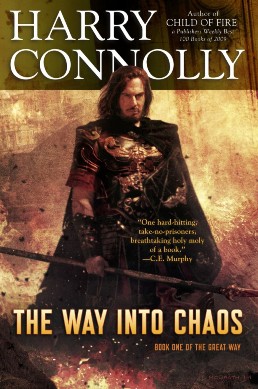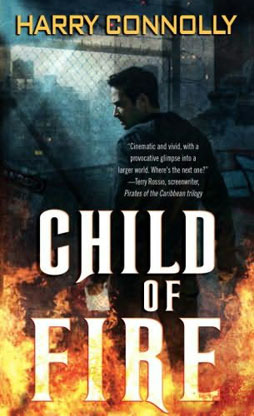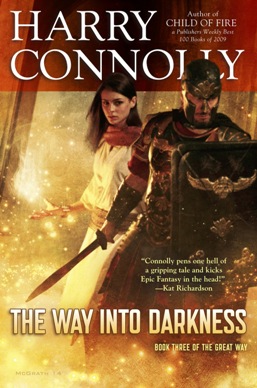More Hardboiled than the Dresden Files: The Way Into Chaos: Book One of The Great Way by Harry Connolly

I’m starting to think that writing a good — by good, I means delivers the tropes while meeting wider literary standards — Big Fat Heroic Fantasy Epic is like squaring a circle, reconciling Justice with Mercy, bringing World Peace… an exercise in balancing seemingly irreconcilable opposites.
You need to have the world building of Tolkien but the pacing of Ian Fleming, the escapism of C.S. Lewis but the grit and cynicism of John Steinbeck. It has to be an armchair-by-the-fire-dog-at-my-feet-on-a-winter-day read, and yet not pretend that pre-modern societies are anything but structurally unpleasant. It needs to take you on a flight of fancy, but ground you in the familiar. And, given that we live in the 21st century, despite the pre-modern setting, it’s nice to have believably empowered women helping to shape the story.
In his new book The Way Into Chaos, Book One of The Great Way, Harry Connolly has somehow managed to do this. Before I put on my writer hat, let me speak as a reader:
I approached this book with some trepidation because I was already a fan of Harry Connolly’s Twenty Palaces urban fantasy series (interview here).
More hardboiled than the Dresden Files, Connolly’s take on the UF genre has a delicious bleakness to it. His hero faces not just a nihilistic a-human magical world with shades of Lovecraft (…more grown up, more disquieting; you could almost call it Atheist Urban Fantasy) but also the bleaker corners of America. His mean streets and bedeviled small towns are as alienating as the magic, not leather-jacket-cool, not picket-fence cozy. His magic feels real in a maggots-under-the-skin way, and his horror elements throw into relief the things we truly care about. The plot and pacing meanwhile makes what could be an emotional battering into an adventure.

The thing is, I rarely find I can trail authors between genres. I love Elizabeth Moon’s Eccentric Horse Aunts in Space books, but utterly bounced off her Fantasy: all the character agency and author pragmatism I relished about her Space Opera seemed absent as poor old Paksenarrion was kicked around a Fantasy world where a pre-modern mercenary organisation was better organised and more enlightened than the modern military (can we invent the term “Merc-y Sue?”). Similarly, I am hooked on the godlike Jim Butcher’s
Dresden Files but rebounded so badly off his Fantasy effort that I ricocheted through several Conan stories before my palate was cleansed. It was as if entirely different authors were at work.
Epic Fantasy Connolly, however, is the same writer as Urban Fantasy Connolly. Not copy-and-paste the same, but with a similar approach to tropes. His magic is still threatening and not quite comfortable. His violence is still realistic and full of consequences. His people still feel real. There’s still a strong sense of human values and human failings. The end result is in the same league as Joe Abercrombie and Patrick Rothfuss and definitely worth a read — I couldn’t put the thing down and read it in three long sittings.
So that’s me with my reader hat on.
Now I’ll put on my writer hat and drag the thing into the lab for dissection. This naturally entails spoilers, so read on at your peril, or go buy the book, read it and come back…
Connolly is effective and economic in his approach to characters.
He gives us two contrasting point-of-view characters — Mage Girl and Old Soldier — and initially defines them by their conflict with each other. This enables him to alternate points of view for pacing and variation, and to give a sense of passage of time. He does not, however, get locked into alternating chapters.
He makes both these lead characters competent, meaning that ultimate victory is at least plausible, but then sends each off on the other’s quest; Mage Girl turns military scout and Old Soldier goes looking for magic (LOL). As the story progresses and the characters diverge, each is also in conflict with their own nature; Mage Girl must resist the pull of magic or become “hollowed out”, whilst Old Soldier must reconcile his humanity with his privileged existence and talent for killing people.
The other characters are either in conflict with one or more of the point-of-view characters, or represent one aspect of their inner struggle, or champion one of the many sides of the conflicts driving the story. This includes the characters or entities making up his world — all the different nations are in conflict with the Empire, and the Empire itself is beset by centrifugal forces.

This definition-by-conflict is effective because it’s what we humans are programmed to notice — who are the allies and enemies — and economical because one conflict can define two characters.
Connolly’s world building is both traditional and original, and he makes both work for him.
He delivers the traditional Fantasy tropes… magic and warriors, elves and quasi-medieval setting… but does with enough of a twist that it’s not same old same old. His adherence to tradition lets him question and explore certain archetypes, especially the feudal structure and the apparent glory of empires — in this he’s a bit like JK Rowling, setting up a story world and then slowly showing us its underside.
A traditional Fantasy world can be a bit predictable. However, he uses this in order to generate considerable suspense. Thus we know that the invaders work like a werewolf plague well before the characters do, and guess that magic has an unpleasant cost even as we see Mage Girl forging ahead towards paying that cost. It’s like those Horror movies when we know the basement contains the killer because we know what genre we’re watching. This is one heck of a useful literary trick.
Finally we come to how he handles structure.
The main structural difficulty with Epic Fantasy is that it’s “epic”, not epic as in deed (“OMG that partisan blow did you see the way the blade sheared through skull and jaw…?“) but epic in as in length (“Holy #### did I just read three metric feet of paperback over three months?“).
You need enough conflict to fill three big fat volumes, that plot has to have enough shape that the book doesn’t feel like a random rollercoaster. This means that the first volume is pretty much the Protagonists being swept out to sea.
Things Get Worse is where I think a lot of books go wrong. Sure they do have to get worse, and the worsening builds up the tension. However nobody (these days) wants to watch a passive protagonist being buffeted around for 100K words of misery.
Most modern writers realise this, so they show the protagonists struggling against the worsening; how much can they save? Alas, we know the struggles are ultimately going to mostly fail because we know what kind of book we are reading. Not only does this destroy suspense, it also makes us feel that the story hasn’t really started yet (I think this is why I didn’t like Butcher’s foray into this genre).
More savvy writers give us more pressing local opposition for the protagonists to face, e.g. bandits in the woods. That can be fine except that after a while the book can read like a transcript of a D&D campaign.
Connolly, however, does what the best writers do and gives his protagonists (albeit, evolving) goals from the start. Better yet, he makes them already competent. Old Soldier is pretty much Maximus. No basic training required. And Mage Girl, though a teenager, is cynical and self-reflective enough that we don’t have to put up with endless cringey gaucheness. So, if they are being swept out to sea, they are each individually trying to swim across the current towards interesting rocks.
Then he uses the other techniques in interesting ways. The local opposition comes in the form of the effects of a crumbling empire, itself caused by the Big Bad. Once loyal vassals turn rogue. The roads are no longer safe from robber barons and so on. So though it’s local opposition it’s very much tied to the main conflict of the story. Meanwhile, both protagonists fight against the worsening — how many friends can they save, how bad will things really get? This works because Connolly has the knack of conjuring up lots of engaging characters and then — GRRM fashion — snuffing them out. You don’t even know whether both the protagonists will survive since he obviously only needs one to carry on with the second book…
The ending…. OK even though I warned you about spoilers, I’m not going to spoil the ending. One day I’ll meet Harry Connolly at a convention and it’ll be impossible for me to buy him beer if he’s already broken my fingers and punched me in the nose. You’ll just have to read the book for yourself.
M Harold Page (www.mharoldpage.com) is a Scottish-based writer and swordsman with several franchise books on Amazon. His creative writing handbook, Storyteller Tools is now available on Amazon.
[…] apocalyptic thriller. The first volume, The Way into Chaos received a great review right here on Black Gate, and at BoingBoing, too. It also got a star from Publishers Weekly. Check out this (clickable) […]